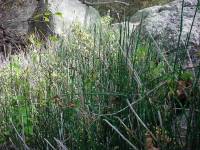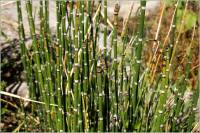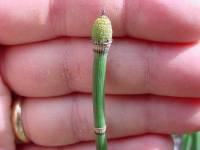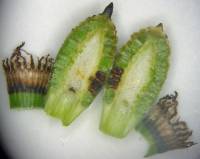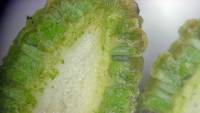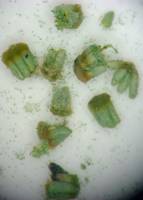Aerial stems persisting more than a year, unbranched, 18--220 cm; lines of stomates single; ridges 14--50. Sheaths when mature dark-girdled, brown to gray above girdle, squarish in face view, 4.5--17 × 3.5--18 mm; teeth 14--50, articulate and promptly shed or persistent. Cone apex pointed; spores green, spheric. 2 n =216.
Cones maturing in summer, old stems sometimes developing branches with cones in spring. Moist roadsides, riverbanks, lakeshores, woodlands; 0--3000 m; Alta., B.C., Man., N.B., Nfld., N.W.T., N.S., Ont., P.E.I., Que., Sask., Yukon; Alaska including the Aleutian Islands, all other states; Mexico; Central America in Guatemala.
In southern and central to western regions plants tend to be taller and have more persistent teeth ( Equisetum robustum , E . prealtum ); in the Far West they often have bituberculate ridges ( E . hyemale var. californicum ). Equisetum hyemale subsp. hyemale is found in Europe and Asia to northwestern China in Xinjiang.
Perennial herbaceous fern ally 18 cm - 2.2 m tall
Spores: green, spheric, and released from lengthwise slit in spore sacs (sporangia).
Stems: one to several, erect, straight, unbranched, green (even during winter), often robust, round with hollow center and fourteen to fifty lengthwise rows of ridges and alternating valleys on outside. The stem joints have distinct nodes, and the stomates are sunken and arranged in single lines on each side of the stem valleys.
Sheaths: brown to gray with dark ring (girdle) at base, 4.5 - 17 mm long, 3.5 - 18 mm wide, square in face view. The sheaths are actually small, fused, whorls of leaves.
Sheath teeth: fourteen to fifty, usually shed along a particular darkish line (articulation line) or sometimes more persistent.
Similar species: Equisetum hyemale ssp. affine is most similar to E. laevigatum and E. variegatum, but both those species lack the dark girdle around all the stem sheaths, their sheaths are more elongate, and they often have less teeth per sheath (only up to twelve in E. variegatum). Equisetum laevigatum further differs by having a blunt tip on the cone even if it abruptly appears to come to a point. The hybrid between E. hyemale and E. laevigatum is E. x ferrissii, which differs from E. hyemale by having only up to 32 teeth per sheath, the sheaths are longer than wide, and the spores are white and misshapen. The hybrid with E. variegatum, E. x mackaii, can be differentiated because it has only up to about sixteen teeth per sheath, the sheaths are elongate (longer than wide), the teeth are persistent, and the spores are white and misshapen. The typical subspecies, E. hyemale ssp. hyemale, only occurs in Europe and Asia.
Habitat and ecology: Common, often along moist slopes and embankments as well as in pastures, degraded prairies, or along roadsides.
Occurence in the Chicago region: native
Notes: This plant often produces large colonies of green stems that persist through the winter. As in other members of this genus, E. hyemale ssp. affine is able to absorb and deposit silica in its stems. Apparently it is due to the harsh silica in the stems that pioneers used the plants to scour pots and pans. The genus Equisetum (the only living members of the Equisetaceae family) has been studied often as a means to understand the evolution of vascular plants. They are often also used to interpret fossil plants in a group called the sphenopsids, which first appeared in the Devonian Period (about 360 to 415 million years ago). At that time, the plants were treelike and reached sizes of well over 10 m tall and even 1 m in diameter. The group reached a point of high diversity in the Carboniferous (300 to 360 million years ago) when the majority of our coal deposits started forming from these and other plants. Today only these small plants (up to about 2 m tall and under 4 cm diameter in our largest species) survive from this once land-dominating group.
Etymology: Equisetum comes from the Latin words equus, meaning horse, and saeta, meaning bristle. Hyemale (or Hiemale), is from the Latin hiems, meaning winter or winter flowering. Affine means related or similar.
Author: The Field Museum
STEMS: with minute tubercles in 1 row along the ridges.
TEETH: irregularly persistent.
NOTES: See also parent taxon. Banks of streams and rivers, marshy meadows, roadside ditches: Apache, Cochise, Coconino, Gila, Graham, Maricopa, Mohave, Navajo, Pima, Santa Cruz, and Yavapai cos. (Fig. 1B); 900-2600 m (2850-8500 ft); June-Sep; U.S., Can. Mex., Guatemala
REFERENCES: G.Yatskievych and M.D. Windham , 2008, Vascular Plants of Arizona: Equisetaceae. CANOTIA 4 (2): 41-45.
Infrequent throughout the state. It is usually found in rather moist, sandy soil and on the slopes of the banks of streams; sometimes the habitat may even be springy. It grows in colonies, and these sometimes may extend along the bank for several rods. It rarely occurs in other habitats but is found along railroad embankments and in wet prairie habitats.



